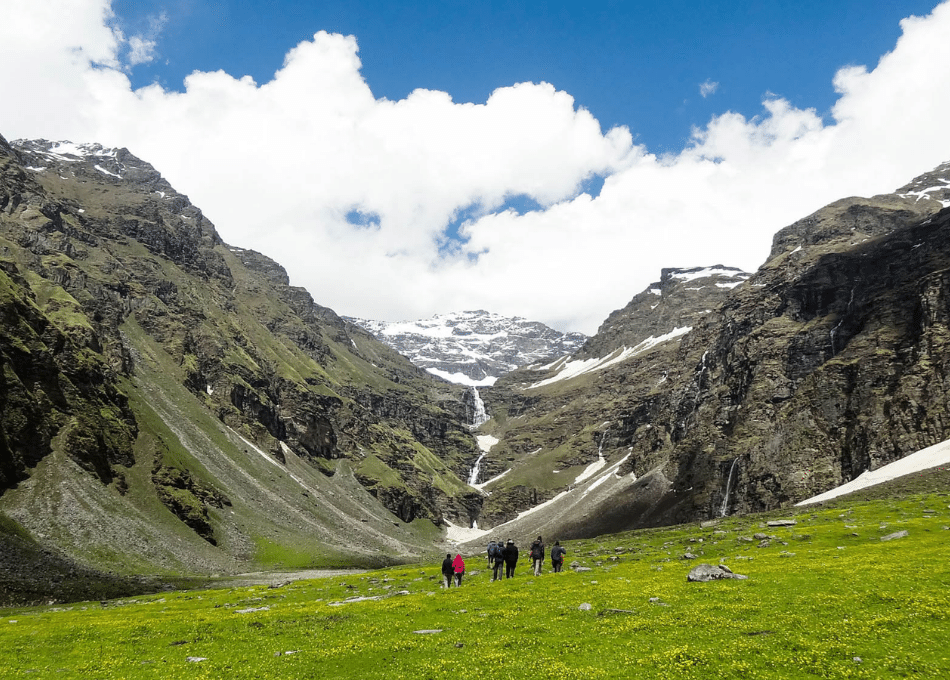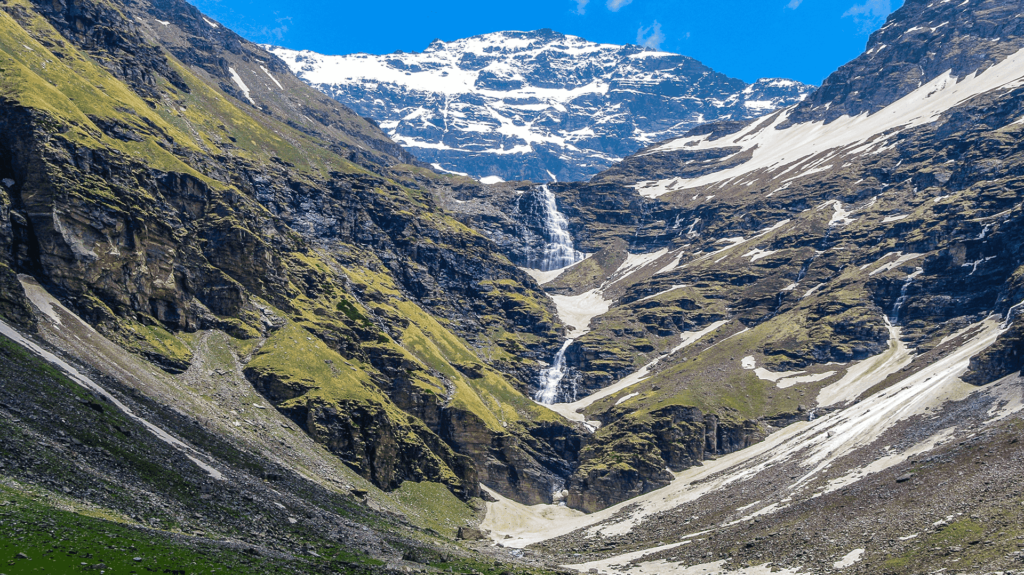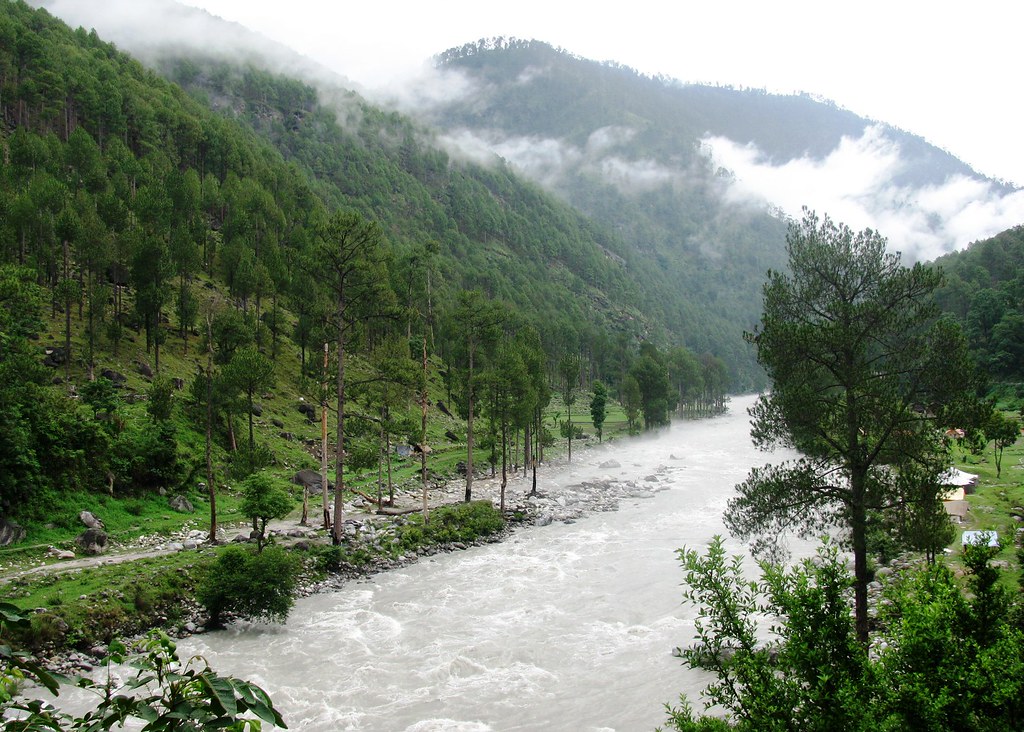Best Time to Trek Rupin Pass: An Expert’s Comprehensive Guide
Overview of the Rupin Pass Trek
What is the Rupin Pass Trek?
The Rupin Pass Trek is a spectacular high-altitude adventure located in the Indian Himalayas, spanning the states of Himachal Pradesh and Uttarakhand. Known for its breathtaking landscapes, diverse terrain, and challenging trails, the trek is a favorite among seasoned hikers and nature enthusiasts. The trek covers approximately 152 kilometers (95 miles) and takes around 8 to 12 days to complete, depending on the pace and itinerary.
Rupin Pass stands at an elevation of 4,650 meters (15,255 feet) and serves as the high point of the trek, offering panoramic views of the surrounding peaks and valleys. The trek traverses through lush meadows, dense forests, alpine lakes, and snow-covered paths, providing an ever-changing landscape that keeps trekkers captivated.

Key Highlights and Attractions
One of the trek's highlights is the stunning Rupin Waterfall, a majestic cascade that flows dramatically down the mountain slopes. Another major attraction is the unique alpine meadows of Dhumdhar Kharak and Ronti Saddle, which are vibrant with seasonal blooms and offer spectacular views of the surrounding peaks. Additionally, the trek passes through traditional Himalayan villages where trekkers can experience the local culture and hospitality.
Ideal Times to Trek Rupin Pass
Summer (June to August): Pros and Cons
Pros:
- Weather: Summer is considered one of the most favorable times to trek Rupin Pass. The weather is generally pleasant, with temperatures ranging from 15°C to 20°C (59°F to 68°F) during the day and cooler temperatures at higher altitudes.
- Trail Conditions: The snow has largely melted, making the trails more accessible and reducing the risk of slipping. The views are clear, and the landscape is lush and green, with wildflowers in full bloom.
- Accessibility: Summer months see fewer roadblocks and easier access to trailheads due to stable weather conditions. The trekking routes are less likely to be affected by snow or ice, making it easier to follow the path.

Cons:
- Crowds: Summer is a popular trekking season, so the trails can be crowded, particularly in the peak months of June and July. This can affect the serenity and solitude that some trekkers seek.
- Cost: Accommodation and permits can be more expensive due to high demand. Early booking is essential to secure the best options.
Monsoon (July to September): What to Expect

Pros:
- Lush Landscape: The monsoon season brings heavy rainfall, which transforms the landscape into a vibrant, lush green. The meadows and valleys become lush with vegetation, offering a beautiful, verdant scenery.
- Fewer Trekkers: Due to the unpredictable weather and challenging conditions, the number of trekkers is lower during the monsoon season. This can lead to a more tranquil and solitary experience on the trail.
Cons:
- Trail Conditions: Heavy rainfall can cause the trails to become muddy and slippery, increasing the difficulty of the trek. Rivers and streams may swell, making crossings hazardous.
- Weather: The monsoon season is characterized by frequent rain showers and overcast skies. This can lead to poor visibility and discomfort, especially when camping in wet conditions.
- Leeches and Insects: The increased moisture attracts leeches and insects, which can be a nuisance to trekkers.
Autumn (September to November): Why It’s a Great Choice
Pros:
- Weather: Autumn is considered the best time to trek Rupin Pass. The weather is typically stable and dry, with clear skies and comfortable temperatures ranging from 10°C to 20°C (50°F to 68°F).
- Trail Conditions: The trails are usually in excellent condition after the monsoon rains have passed. Snow is minimal, making the trek more manageable and enjoyable.
- Views: The clear skies offer stunning panoramic views of the Himalayas and the surrounding valleys. The autumn colors enhance the beauty of the landscape, creating a picturesque setting.
Cons:
- Crowds: While less crowded than summer, autumn still sees a significant number of trekkers. Booking in advance is recommended to secure accommodation and permits.
- Cold Nights: Nights can get chilly, especially at higher altitudes. Proper gear is necessary to stay warm during the nights.
Winter (December to February): Challenges and Rewards

Pros:
- Solitude: Winter offers a unique and tranquil trekking experience. The trails are much less crowded, providing a sense of solitude and peace.
- Snow-Covered Landscape: The winter season transforms the landscape into a winter wonderland, with snow-covered peaks and frozen lakes adding to the trek’s beauty.
Cons:
- Extreme Cold: Winter temperatures can drop significantly, especially at higher elevations. Trekkers must be prepared for freezing conditions and potential snowstorms.
- Trail Conditions: Snow and ice can make the trails treacherous and challenging. Specialized gear, such as crampons and ice axes, may be required.
- Access Issues: Snow and adverse weather conditions can lead to roadblocks and delays in reaching the trailhead.
Factors Influencing the Best Time to Trek
Weather Conditions and Their Impact
The weather is a crucial factor in determining the best time to trek Rupin Pass. The Himalayas are known for their unpredictable weather, and conditions can vary significantly based on the season. Summer offers the most stable weather, with clear skies and pleasant temperatures. Monsoon brings heavy rains and increased humidity, affecting trail conditions. Autumn provides the best combination of favorable weather and trail conditions. Winter, while offering a unique experience, poses significant challenges due to extreme cold and snow.
Trail Conditions and Accessibility
Trail conditions are heavily influenced by the season. In summer, the trails are generally clear, though they can be crowded. Monsoon rains can make trails slippery and difficult to navigate. Autumn usually offers the best trail conditions, with minimal snow and stable paths. Winter conditions can make the trails hazardous, requiring additional gear and experience.
Crowd Levels and Accommodation Availability
The number of trekkers can impact your experience. Summer and autumn are popular times, leading to more crowded trails and higher costs for accommodation and permits. Monsoon sees fewer trekkers, providing a quieter experience but with less predictable weather. Winter has the fewest trekkers, offering solitude but with significant challenges.
Planning Your Rupin Pass Trek
Essential Permits and Regulations
To trek Rupin Pass, trekkers need to obtain permits from the local authorities. These include the Inner Line Permit (ILP) and permits for the National Park if applicable. It’s essential to check the latest regulations and secure permits well in advance to avoid any last-minute issues.
What Gear to Bring and How to Prepare
Summer Gear:
- Lightweight clothing
- Sunscreen and hat
- Trekking poles
Monsoon Gear:
- Waterproof clothing
- Anti-leech socks and repellent
- Waterproof trekking boots
Autumn Gear:
- Warm layers for cooler nights
- Good-quality trekking shoes
- Warm sleeping bag
Winter Gear:
- Insulated clothing
- Crampons and ice axe
- High-quality, insulated boots
Proper preparation includes physical conditioning, understanding the terrain, and being aware of the local weather patterns.
Tips for First-Time Trekkers
For first-time trekkers, it’s essential to:
- Train adequately before the trek to build stamina and strength.
- Start with shorter, less challenging treks to build confidence.
- Learn basic trekking skills and safety measures.
- Ensure all gear is in good condition and suitable for the trek.
Insights from Experienced Trekkers
Personal Stories and Recommendations
Experienced trekkers often emphasize the importance of flexibility in planning. Many recommend trekking in autumn for the best balance of weather and trail conditions. Sharing personal experiences, such as dealing with unexpected weather changes or the joy of reaching the pass, adds valuable insights.
Advice from Local Guides
Local guides provide essential information on the best times to trek based on their extensive knowledge of the region. They offer practical advice on navigating the trails, avoiding potential hazards, and making the most of the trek.
Local Tips and Services
Where to Stay Near Rupin Pass
Accommodation Options:
- Guesthouses in nearby villages such as Jhaka and Sangla.
- Camping options along the trek with local support.
Transportation:
- Shared jeeps or private taxis from major towns like Shimla or Manali to the trailhead.
Recommended Local Guides and Services
Hiring a local guide can enhance your trekking experience. Guides offer not only navigation assistance but also insights into the local culture and environment. They can help with logistical arrangements and ensure a safer trek.
Climate Overview: How Seasons Affect Your Trek
Temperature Variations Throughout the Year
The Rupin Pass, nestled in the Indian Himalayas, offers a diverse climate throughout the year. During the summer months, temperatures at lower altitudes can be pleasantly warm, but as you ascend, they drop significantly. Conversely, winters bring frigid temperatures with heavy snowfall at high elevations, creating a pristine yet challenging environment. Understanding these temperature shifts is crucial for planning your trek.
How Elevation Influences Weather Patterns
The weather in the Rupin Pass region varies dramatically with elevation. At lower altitudes, you might encounter mild temperatures and occasional rainfall. As you climb higher, temperatures plummet, and the risk of encountering snow and ice increases. The high-altitude conditions can lead to sudden weather changes, making it essential to be prepared for a range of conditions.
Comparing the Seasons: Which is Right for You?
Season-by-Season Trekking Experience
Spring
Spring (April to June) is a favorite among trekkers for its blooming meadows and moderate temperatures. This season is marked by vibrant wildflowers and the emergence of baby animals. It’s a picturesque time, with clear skies and moderate weather, making the trek more enjoyable.
Summer
Summer (July to September) brings warmer temperatures at lower elevations but also introduces the monsoon season. Expect frequent rain showers, which can make trails slippery and streams more challenging to cross. However, the lush green landscapes and diverse wildlife make it a rewarding experience for those prepared for the rain.
Autumn
Autumn (October to November) is another prime time for trekking, with crisp, clear weather and stunning views. The temperatures are cooler but not freezing, and the fall colors add a beautiful touch to the landscape. It’s a great season for trekking if you want to avoid the heavy snowfall of winter.
Winter
Winter (December to March) offers a serene, snow-covered landscape, ideal for those seeking solitude and a winter adventure. Temperatures drop significantly, and snow can make the trails challenging. Winter trekking requires careful planning and the right gear to stay safe and warm.
Matching Your Trekking Goals with the Best Season
Each season offers unique experiences that align with different trekking goals. If you seek vibrant landscapes and milder weather, spring and autumn are ideal. For those who love the challenge of snow and quieter trails, winter is perfect. Summer is suited for trekkers who enjoy lush scenery and don’t mind the rain.
Unique Experiences in Each Season
Wildlife and Flora: Seasonal Changes Along the Rupin Pass
What to Expect in Spring
In spring, the meadows are adorned with wildflowers in full bloom, and baby animals can be spotted as they venture out. The weather is relatively mild, making it an excellent time for nature enthusiasts.
Summer Wildlife
Summer brings high-altitude species that are adapted to the warmer months. You might encounter Himalayan tahr, bharal (blue sheep), and various bird species. The vibrant flora and fauna create a lively atmosphere, despite the challenges of rain.
Cultural Festivals and Local Life
Participating in Local Festivals During the Trek
Trekking in different seasons allows you to experience local festivals and cultural events. In spring and autumn, you might witness traditional festivals celebrated in the mountain villages, adding a cultural dimension to your trek.
Understanding the Seasonal Rhythms of Mountain Villages
Mountain villages have their own seasonal rhythms, with local activities and traditions varying throughout the year. Engaging with these rhythms can provide a deeper understanding of the region’s culture and way of life.
Preparing for Seasonal Challenges on the Rupin Pass
Monsoon Trekking: How to Stay Safe and Enjoy the Rain
Essential Rain Gear and Waterproofing Tips
Monsoon treks require high-quality rain gear. Invest in waterproof jackets, pants, and gaiters to keep yourself dry. Waterproofing your gear and maintaining it regularly can make a significant difference in your comfort and safety.
Navigating Slippery Trails and Stream Crossings
Slippery trails and swollen streams are common during the monsoon. Use trekking poles for stability, and choose sturdy, water-resistant footwear to handle wet conditions.
Winter Trekking: Surviving the Cold and Snow
Layering Techniques for Winter Comfort
Winter trekking demands proper layering to manage cold temperatures effectively. Use moisture-wicking base layers, insulating mid-layers, and a waterproof, windproof outer layer to stay warm and dry.
Dealing with Shorter Days and Long Nights
Winter days are shorter, so plan your hikes to finish before dark. Carry a reliable headlamp and extra batteries to ensure safety during the long nights.
Expert Advice: Maximizing Your Rupin Pass Trek Experience
Training for the Trek: How to Get Fit for Each Season
Specific Exercises for High-Altitude Endurance
Prepare for high-altitude trekking with cardio exercises, strength training, and altitude acclimatization. Incorporate interval training and hiking at higher elevations into your routine to build endurance.
Acclimatization Strategies for a Successful Trek
Gradual acclimatization is key to preventing altitude sickness. Ascend slowly, stay hydrated, and allow time for your body to adjust to the higher elevations.
Packing Tips for Different Seasons
Must-Have Gear for Summer, Monsoon, Autumn, and Winter
Each season requires specific gear. Summer demands lightweight clothing and rain protection, while winter necessitates heavy-duty gear for warmth and snow safety. Ensure your packing list includes season-specific essentials to stay comfortable and safe.
Lightweight vs. Heavyweight Gear: Making the Right Choice
Choose lightweight gear for summer and autumn treks for ease of movement. For winter, opt for heavyweight, insulated gear to combat the cold.
Environmental Impact and Responsible Trekking
Leave No Trace: Protecting the Rupin Pass Environment
Best Practices for Minimizing Your Footprint
Follow Leave No Trace principles to minimize your impact on the environment. Stick to established trails, pack out all trash, and avoid disturbing wildlife.
How Different Seasons Affect Environmental Impact
Be aware that different seasons can impact the environment in various ways. For example, snowmelt in spring can lead to increased erosion, while summer rains can exacerbate trail wear. Adjust your trekking practices to mitigate these impacts.
Supporting Local Communities
How Seasonal Tourism Benefits Local Economies
Seasonal tourism can provide vital income for local communities. Respect local customs and contribute to the economy by staying in local accommodations and purchasing local goods.
Ethical Considerations When Trekking in Remote Areas
Trekking in remote areas requires sensitivity to local cultures and environments. Approach with respect, and support efforts to preserve the natural and cultural heritage of the region.
Post-Trek Considerations
Recovering from the Rupin Pass Trek
Tips for Post-Trek Rest and Recovery
After completing the trek, allow ample time for rest and recovery. Stretching, proper hydration, and balanced nutrition will help your body recuperate.
How to Maintain Your Trekking Fitness
Continue with a balanced fitness routine to maintain the endurance and strength gained during your trek. Incorporate hiking or trekking-specific exercises to stay in shape.
Sharing Your Experience
Writing a Trekking Journal: Capturing the Seasons
Document your experiences in a trekking journal. Include details about the different seasons, the challenges you faced, and the memories you made.
Photography Tips for Each Season on the Rupin Pass
Capture the beauty of each season with thoughtful photography. Use natural light to highlight seasonal features and be mindful of changing weather conditions.
Conclusion: Choosing the Best Time for Your Trek
Summary of Key Points
Choosing the best time to trek Rupin Pass depends on personal preferences and priorities. Summer offers pleasant weather but can be crowded. Monsoon provides a lush landscape but with challenging conditions. Autumn is ideal for the best overall experience, while winter offers solitude and stunning snow-covered views but requires additional preparation.
Final Recommendations
For most trekkers, autumn (September to November) is the recommended time due to the stable weather and excellent trail conditions. However, each season has its unique appeal and challenges. Trekkers should consider their experience level, desired trek conditions, and personal preferences when planning their trek.
Hello! I’m,Ratndip a dedicated trekking enthusiast with a deep love for exploring the world’s most captivating trails. With over 2 years of trekking experience, I’ve had the privilege of hiking through stunning landscapes, from the majestic Himalayas to the lush Amazon rainforest. My journey into trekking started as a personal quest for adventure and has evolved into a lifelong passion for discovering new terrains and connecting with nature.